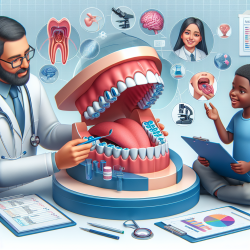Introduction
As practitioners in the field of speech-language pathology, our primary focus is on creating positive outcomes for children. Understanding the intricate connections between various disorders can significantly enhance our therapeutic approaches. A recent study, "Malocclusion in children with speech sound disorders and motor speech involvement: a cross-sectional clinical study in Swedish children," sheds light on the relationship between malocclusion and speech sound disorders (SSD) in children. This blog explores the study's findings and offers insights on how practitioners can leverage this knowledge to improve their clinical practice.
Key Findings of the Study
The study investigated the prevalence, types, and severity of malocclusions in children with SSD compared to those with typical speech development (TSD). The results were eye-opening:
- 61% of children with SSD had a malocclusion, compared to 29% in the TSD group.
- Malocclusions in the SSD group were more severe, with functional posterior crossbite and habitual lateral/anterior shift appearing more frequently.
- Class III malocclusion, anterior open bite, and scissors bite were found exclusively in the SSD group.
These findings suggest a significant association between SSD and malocclusion, indicating that children with SSD are more likely to have severe malocclusions.
Implications for Practitioners
Understanding the link between malocclusion and SSD can guide practitioners in several ways:
- Comprehensive Assessments: Incorporate evaluations of orofacial characteristics and malocclusion in routine assessments for children with SSD. This holistic approach can uncover underlying issues that may impact speech development.
- Interdisciplinary Collaboration: Work closely with orthodontists and dental professionals to address malocclusions early. Collaborative care can lead to more effective treatment plans and improved outcomes for children.
- Targeted Interventions: Develop speech therapy interventions that consider the child's orofacial structure and malocclusion. Tailoring therapy to address these factors can enhance speech intelligibility and overall communication skills.
Encouraging Further Research
While this study provides valuable insights, it also highlights the need for further research. Practitioners are encouraged to explore the following areas:
- Investigate the genetic and environmental factors contributing to the co-occurrence of malocclusion and SSD.
- Examine the long-term impact of early orthodontic intervention on speech development in children with SSD.
- Study the effectiveness of integrated therapy approaches that address both speech and dental issues concurrently.
Conclusion
The connection between malocclusion and SSD underscores the importance of a multidisciplinary approach in treating speech disorders. By understanding and addressing the orofacial characteristics associated with SSD, practitioners can significantly enhance their therapeutic strategies, leading to better outcomes for children.
To read the original research paper, please follow this link: Malocclusion in children with speech sound disorders and motor speech involvement: a cross-sectional clinical study in Swedish children.










